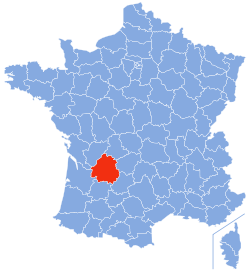Dordogne
Dordonha (Occitan) | |
|---|---|
From top down, left to right: prefecture building in Périgueux, Château de Castelnaud-la-Chapelle, river Lourde and La Roque-Gageac | |
 Location of Dordogne in France | |
| Coordinates: 45°0′N 0°40′E / 45.000°N 0.667°E | |
| Country | France |
| Region | Nouvelle-Aquitaine |
| Prefecture | Périgueux |
| Subprefectures | Bergerac Nontron Sarlat-la-Canéda |
| Government | |
| • President of the Departmental Council | Germinal Peiro[1] (PS) |
| Area | |
• Total | 9,060 km2 (3,500 sq mi) |
| Population (2021)[2] | |
• Total | 413,730 |
| • Rank | 60th |
| • Density | 46/km2 (120/sq mi) |
| Time zone | UTC+1 (CET) |
| • Summer (DST) | UTC+2 (CEST) |
| Department number | 24 |
| Arrondissements | 4 |
| Cantons | 25 |
| Communes | 503 |
| ^1 French Land Register data, which exclude estuaries and lakes, ponds and glaciers larger than 1 km2 | |
Dordogne (UK: /dɔːrˈdɔɪn/ dor-DOYN, US: /dɔːrˈdoʊn/ dor-DOHN or /dɔːrˈdɔːnjə/ dor-DAWN-yə;[3][4] French: [dɔʁdɔɲ] ; Occitan: Dordonha [duɾˈduɲɔ]) is a large rural department in south west France, with its prefecture in Périgueux. Located in the Nouvelle-Aquitaine region roughly half-way between the Loire Valley and the Pyrenees, it is named after the river Dordogne, which runs through it. It corresponds roughly to the ancient county of Périgord. In January 2023, Dordogne had a population of 412,807.[5]
- ^ "Répertoire national des élus: les conseillers départementaux". data.gouv.fr, Plateforme ouverte des données publiques françaises (in French). 4 May 2022.
- ^ "Téléchargement du fichier d'ensemble des populations légales en 2021" (in French). The National Institute of Statistics and Economic Studies. 28 December 2023.
- ^ "Dordogne" (US) and "Dordogne". Lexico UK English Dictionary. Oxford University Press. Archived from the original on 30 July 2020.
- ^ "Dordogne". Merriam-Webster.com Dictionary. Merriam-Webster. Retrieved 2 September 2018.
- ^ Chassain, Hervé (1 March 2023). "Recensement : pourquoi la Dordogne perd encore des habitants" (in French). ISSN 1760-6454. Retrieved 14 July 2023.





